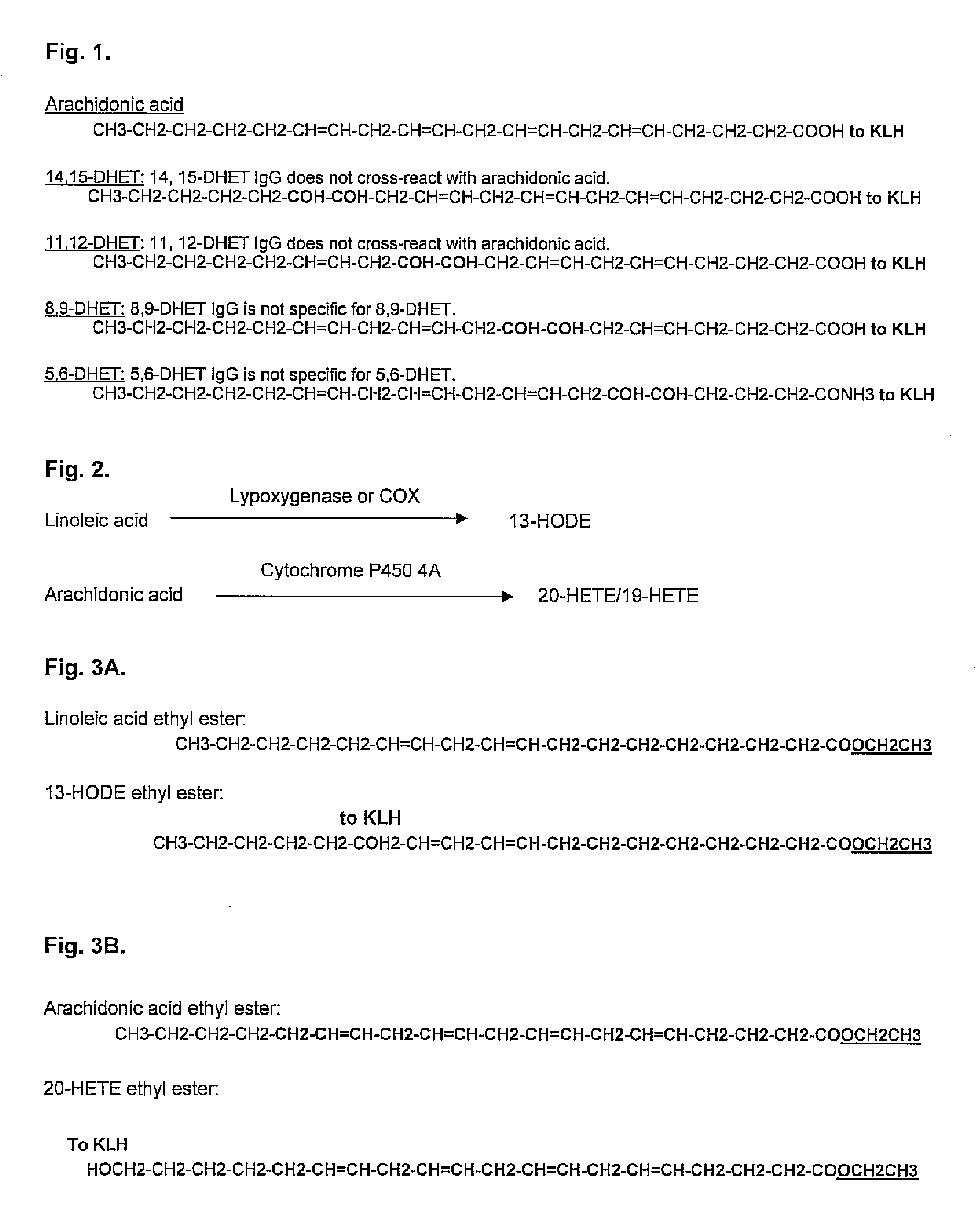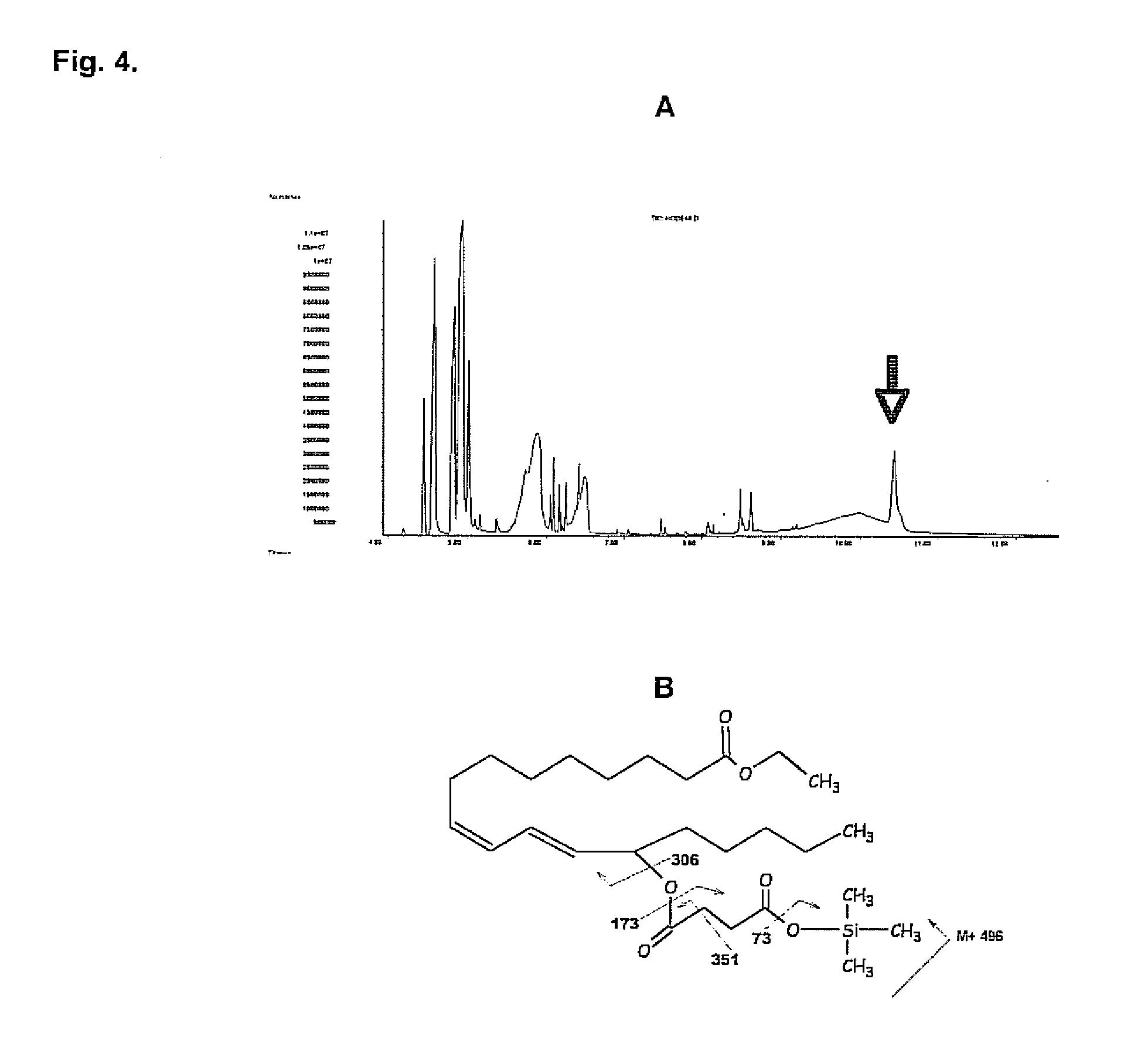Detection of alcohol-esterified fatty acids
a technology of fatty acid esters and detection methods, applied in the field of detection of alcohol use, can solve the problems of difficult to provide the necessary services and medical care, difficult to determine the use of alcohol by self-reporting of mothers, and laborious and expensive instruments
- Summary
- Abstract
- Description
- Claims
- Application Information
AI Technical Summary
Benefits of technology
Problems solved by technology
Method used
Image
Examples
example 1
Development of the Immunoassay of 14,15-, 11,12-, 8,9- and 5,6-DHET
Antibody Production
[0054] Synthetic 14,15-, 11,12- or 8,9-DHETs were coupled to KLH using dicyclohexylcarbodiimide (DCC) as previously described (10). The 5,6-DHET with COOH at C1 blocked by NH3 to prevent lactone formation were coupled to KLH using 1-ethyl-3-(3-dimethylaminopropyl)carbodiimide hydrochloride (EDC) according to the manufacturer's instruction (Pierce Biotechnology, Rockford, Ill).
[0055] The conjugate was used to immunize a goat and antibody titers were determined by ELISA using the DHET-conjugated bovine serum albumin (BSA).
Purification of IgG Fraction of Antisera
[0056] IgG fractions of antibody prepared against the DHETs were purified from sera using protein-G affinity chromatography (Pierce Co.). The IgG bound to the protein G column was eluted with 50 mM glycine-HCl buffer, pH 2.5, and immediately neutralized with 0.5 M tris-HCl, pH 7.6. This procedure did not affect the specificity of the an...
example 2
Development of the Immunoassay of Fatty Acid Ethyl Ester
Production of KLH-, BSA- and HRP-Conjugated with a Derivative of the Hydroxyl Derivative of 13-H ODE Ethyl Ester
[0063] 13-HODE, a metabolite of linoleic acid, was converted to an ethyl ester with lipase (Candida antarctica) acrylic resin and ethyl alcohol in acetone (8) with modification. The ethyl ester was converted to a succinate derivative via its C13 hydroxyl group in the presence of succinic anhydride with 4-dimethylaminopyridine (4-DMAP) as a catalyst in chloroform under an argon atmosphere over 2 days (9). GC / MS analysis was performed after derivatization with MSTFA. The samples were analyzed on a HP 6890 Series GC system with a quadrupole EI / MS detector at 70 eV and a HP-5MS (capillary 30.0 m×250 μm×0.25 μm nominal 5% phenyl methyl siloxane) column. The injector temperature was 250° C. for 2 minutes, with 30° C. / minute increased to 325° C. for 5 minutes. The software program was Enhanced ChemStation. The product was...
PUM
| Property | Measurement | Unit |
|---|---|---|
| temperature | aaaaa | aaaaa |
| temperature | aaaaa | aaaaa |
| optical densities | aaaaa | aaaaa |
Abstract
Description
Claims
Application Information
 Login to View More
Login to View More - R&D
- Intellectual Property
- Life Sciences
- Materials
- Tech Scout
- Unparalleled Data Quality
- Higher Quality Content
- 60% Fewer Hallucinations
Browse by: Latest US Patents, China's latest patents, Technical Efficacy Thesaurus, Application Domain, Technology Topic, Popular Technical Reports.
© 2025 PatSnap. All rights reserved.Legal|Privacy policy|Modern Slavery Act Transparency Statement|Sitemap|About US| Contact US: help@patsnap.com



